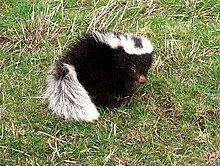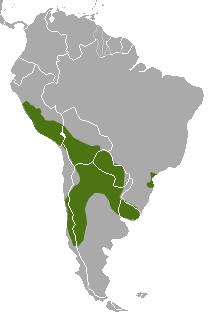Molina's hog-nosed skunk
| Molina's hog-nosed skunk | |
|---|---|
 | |
| Scientific classification | |
| Domain: | Eukaryota |
| Kingdom: | Animalia |
| Phylum: | Chordata |
| Class: | Mammalia |
| Order: | Carnivora |
| Family: | Mephitidae |
| Genus: | Conepatus |
| Species: | C. chinga |
| Binomial name | |
| Conepatus chinga (Molina, 1782) | |
 | |
| Molina's hog-nosed skunk range | |
Molina's hog-nosed skunk, also called the Andes skunk (Conepatus chinga), is a skunk species from South America. It is found in Argentina, Bolivia, Brazil, Chile, Peru, Paraguay, and Uruguay, at elevations up to 5000 m.
Habitat[edit]
The Molina's hog-nosed skunk's native range is throughout mid to southern South America, Chile, Peru, northern Argentina, Bolivia, Paraguay, Uruguay, and southern Brazil.[2] The mammal is therefore associated with temperate regions and open areas, mainly described as the Pampas biome[3] and preferring to live in open vegetation, shrub forest and rocky sloped areas.[2]
Population and distribution[edit]
Typically they will live alone in an average home range size of about 1.66 individuals/km2 with some overlapping and about six skunks per 3.5 km2.[4] Although living in mostly solitary areas, the skunks will come together temporarily for mating purposes.[2]
Diet[edit]
Foraging mainly at night, the skunk is omnivorous, eating birds, small mammals, eggs, insects, leaves, and fruit. The tooth morphology in the Molina's hog-nosed skunk, is different from most mammals in that their teeth are adapted to their omnivorous diet with grinding being the main function of the carnassial apparatus.[5]
Conservation status[edit]
The skunk is listed as "least concern" according to the IUCN Red List. The main threats to the skunk are increased habitat destruction and fragmentation[6] from over exploitation of humans and grazing in agriculture. The skunk is also affected by the planning of new roads and road-kills. Due to improper planning, habitat destruction, and fragmentation, the skunk has started living around man-made structures and along fences and buildings.[6]
References[edit]
- ^ Emmons, L.; Schiaffini, M.; Schipper, J. (2016). "Conepatus chinga". IUCN Red List of Threatened Species. 2016: e.T41630A45210528. doi:10.2305/IUCN.UK.2016-1.RLTS.T41630A45210528.en. Retrieved 19 November 2021.
- ^ a b c Afflerbaugh, Kevin (2002). "Conepatus chinga". Animal Diversity Web. Retrieved September 10, 2013.
- ^ Kasper, Carlos B.; et al. (2012). "Differential patterns of home-range, net displacement and resting sites use of Conepatus chinga in southern Brazil". Mammalian Biology. 77 (5): 358–362. doi:10.1016/j.mambio.2012.03.006.
- ^ Castillo, D. F.; et al. (2011). "Spatial organization of Molina's hog-nosed skunk (Conepatus chinga) in two landscapes of the Pampas grassland of Argentina". Canadian Journal of Zoology. 89 (3): 229–238. doi:10.1139/Z10-110.
- ^ Peters, Felipe Bortolotto; et al. (April 2011). "Feeding Habits of Molina's Hog-Nosed Skunk, Conepatus Chinga (Carnivora: Mephitidae) In The Extreme South of Brazil". Zoologia (Curitiba). 28 (2): 193. doi:10.1590/S1984-46702011000200006.
The grinding function of the carnassial ap-paratus in skunks (Vaughan et al. 1999) is considered to be appropriate for a diet with a predominance of beetles: small prey that offer lower physical resistance.
- ^ a b Castillo, Diego F.; et al. (July 2011). "Denning ecology of Molina's hog-nosed skunk in a farmland area in the Pampas grassland of Argentina". Ecological Research. 26 (4). The Ecological Society of Japan: 845–850. doi:10.1007/s11284-011-0855-y. S2CID 35862526.
Increasing habitat destruction and fragmentation has a tremendous influence on mesocarnivore communities.


 French
French Deutsch
Deutsch